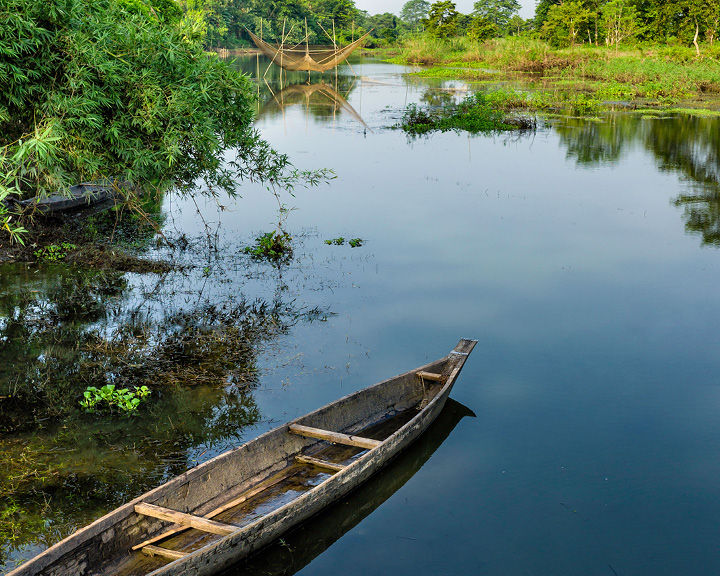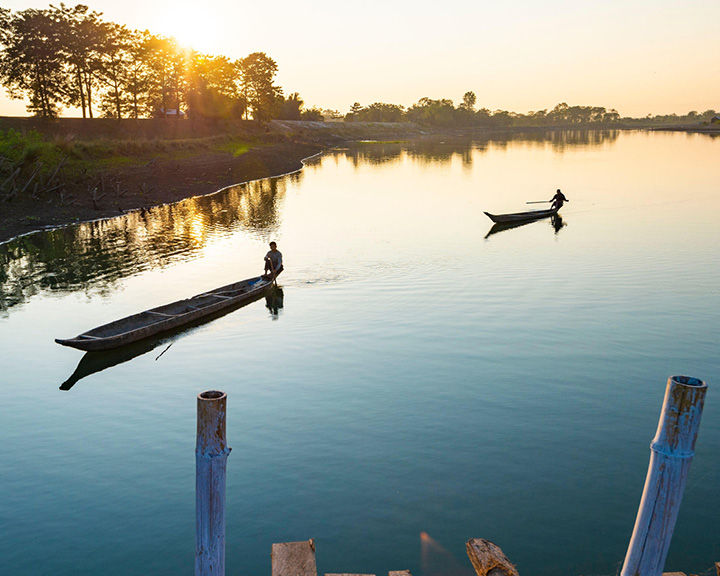
The world’s largest river island, Majuli, located on the River Brahmaputra in Assam, is a magical world grappling with the threats of erosion. By Poonam Binayak
Majuli, the world’s largest river island, rests in the bosom of the mighty River Brahmaputra, which flows through the Northeast Indian state of Assam. Measuring 900 square kilometres in the early 1990s, Majuli is now down to 352 square kilometres, yet it’s bigger than 11 sovereign countries. If Brahmaputra’s wrath continues, Majuli, continually eroded by the moving waters, will disappear in the next 20 years. Despite the impending existential threat, Majuli strives to preserve and share its cultural heritage.
THE LIFELINE
Life in Majuli is serene—a perfect antidote to the often unsettling city life—unless the Brahmaputra is hungry or the rain god is angry. From July to September, during the monsoons, Majuli gets flooded. The local bamboo huts built on stilts seemingly float then. Locals use their dinghies to travel within the island. When it’s not flooded, people in Majuli go about merrily on their bicycles and motorbikes.

While most men here are into farming, fishing, and boat-making, women indulge in weaving, pottery, and handloom weaving. Majuli never fails to indulge guests, though. Locals welcome visitors with a warm smile and are always up for a quick chat. They love inviting visitors home for a delicious traditional meal that includes purang apin (sticky rice wrapped in plantain leaves) and apong (rice beer). You can even learn the art of pottery from local artisans. Cycling along the dirt roads that cut through paddy fields, while watching the locals go about their daily lives, is bliss. Rent a bicycle at Majuli Cycle Cafe in Garamur village for INR 200/USD3 per day. This cafe also has a library, an art gallery, and a coffee shop.

CULTURE TRIP
The satras—neo-Vaishnavite monasteries and centres of art —where prayers, plays, and teachings are conducted, offer the perfect introduction to the cultural canvas of Majuli. Set up in the 15th and 16th centuries by revered saint and reformer Srimanta Sankaradeva (an apostle for an egalitarian society) and his disciples, satras aim for the spiritual upliftment of every individual, irrespective of caste, class, and creed. The river swallowed a few satras of Majuli but many are still operational. Grihasthi satras are run by families and married men, while others are monastic satras called udasin. Here, young boys, committed to the order, grow up within the confines of the monastery.
All of the satras follow tenets of neo-Vaishnavism, yet each of them has a unique artistic attribute. The Auniati Satra, the oldest and biggest of all the monasteries on the isle, acts as a repository of Assam’s history. Its museum has a collection of authentic Assamese handicrafts, antiques, jewellery, ancient utensils, and more. A library within this satra preserves rare Assamese manuscripts and books (entry fee is INR 50/USD1 for foreign nationals).

Adorned with 300-year-old paintings, religious motifs, and animal forms, the Sri Sri Uttar Kamalabari Satra houses manuscripts written by Sankaradeva and several rare antiques. Its cultural stage performances like Bhaona and Sattriya dance make for an interesting evening in Majuli. Remember to take your shoes off before entering a satra.
Epic stories from Indian mythology and folklore, mostly the life of Lord Krishna or scenes from the Ramayana, come to life in the traditional drama form Bhaona, accompanied by dance, hand drums, and cymbals. Usually performed by bholots (monks) in the namghar (prayer hall) of the satras, Bhaona is a spectacle. It’s not a daily event, but if you are lucky, you may catch a performance arranged for a large group of visitors.

The peculiar character masks (mukha) used in Bhaona are made at the Chamaguri Satra, using bamboo, clay, cane, and cloth. At the Chamaguri Satra, you can not only witness this ancient craft tradition but also try your hand at learning the art of mask making.
Sattriya Nritya, recognised as one of India’s classical dances, is another ancient art form initiated by Sankaradeva that has been kept alive. It blends music and dance to convey mythological stories and teachings to its audience.

TRIBAL CONNECTION
While satras and their monks remain the soul of Majuli, the isle is home to many tribal and nontribal communities. The Mishing tribe makes up nearly 60 per cent of the island’s population. Their traditional religious beliefs are animistic, but they follow neo-Vaishnavism and live in harmony with the monks and other communities. Mishing women are predominantly employed in handloom weaving, an essential part of the tribe’s culture. Their mirizen shawls, mekhela chador (traditional women’s attire), and blankets made using traditional handloom techniques and materials are popular and can be purchased from local handloom stalls.
FESTIVAL FRENZY
The monks and other residents keep the cultural landscape of Majuli alive with their festivals, celebrating time-honoured traditions and customs—the most famous one being the Raas Leela. The three-day-long festival, held in November on the full moon day after Diwali called Kartik Purnima, portrays the life of Lord Krishna through dance and drama. The enactment of the birth of Lord Krishna, his childhood pranks, his slaying of demons, and the celebration of the divine love between him and Radha is mesmerising.

In the earlier days, only monks living in satras performed, but today, village troupes also participate in the merrymaking. Character masks are key in Raas Leela as well. The classical Sattriya is performed too. Most satras celebrate Raas Leela, but the main centre is the Dakhinpat Satra. The five-day harvest festival of Ali-Aye Ligang in mid-February is celebrated by the Mishing community with great pomp and show. They thank Donyi Polo (the Sun-Moon God) by performing Gumrag, the traditional Mishing dance.
A BIRDER’S PARADISE
Every winter, hundreds of migrant birds arrive at Majuli for its cool climate, freshwater, and fertile wetlands. Majuli, a twitcher’s paradise at any time of the year, then, sees numerous beautiful species including Siberian cranes, pelicans, whistling teals, Pheasant-tailed jacanas, white wagtails, and storks. They soar over the wetlands on the hunt for insects and fish. The isle’s two main wetlands for birdwatching are Chakoli Beel near Kamalabari and Vereki Beel.
Sunsets in Majuli are nothing short of magical. A calm sunset on the Kamalabari Ghat, as fishermen set out on their boats for the day’s last catch, is the perfect way to end the day here. Majuli is pure, still untouched by the modern world and mindless tourism.
GETTING THERE
You need to catch a ferry to Majuli from Assam’s Jorhat, the isle’s closest, well-connected city. You can fly to Jorhat from Guwahati or Kolkata. Take an autorickshaw or bus from Jorhat Airport to Nimati Ghat (19 km), the ferry departure point. Hop on any government-run ferry to Majuli’s Kamalabari Ghat (20 km), operating from 8.30 am to 3.30 pm, with hourly departures. Return ferries run from 7 am to 3 pm. The frequency is lower during monsoon, and ferries may not be operational when the weather is bad. A one-way ride costs INR 15/USD0.2 per person and there’s an additional charge to take your vehicle along.
STAY
Majuli has some decent guesthouses to pick from. La Maison de Ananda in Kamalabari has options of a concrete cottage and bamboo stilt huts (starts from INR 1,800/USD25; airbnb.co.in). They also arrange meals on request (tribal thali at INR 350/USD5 per person), and bicycles and scooters are available for rental. Me:Po Okum is a basic eco-camp with bamboo huts (starts from INR 1,000/USD14; +91 9435203165). If you wish to stay at the satras, try the Uttar Kamalabari Satra guest house (INR 575/USD7 for two people).
WHEN
The best time to visit is between November and March, during winter. Avoid monsoons, July to September, as most of the island is submerged, and getting around becomes challenging. Carry mosquito repellent and a basic medical kit, irrespective of the season.
IDEAL FOR
Culture vultures, nature lovers, and those looking for a remote, rustic, and relaxed holiday.
DISCOVER
Take a tour of the paddy fields. A picnic at Tengapania, located on the banks of Brahmaputra, and a trip to the Potter’s Village in the Salmora area are recommended.
Related: Your Ultimate Guide To Udaipur: All You Need To Know About The City Of…










